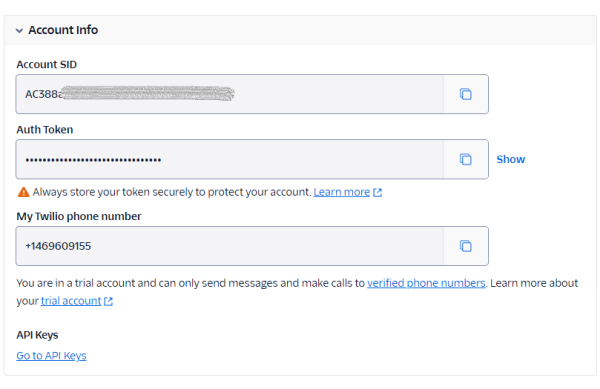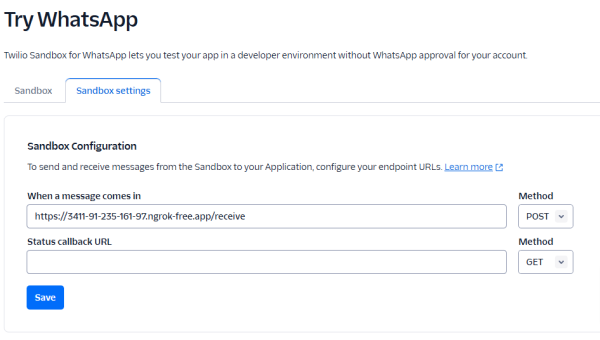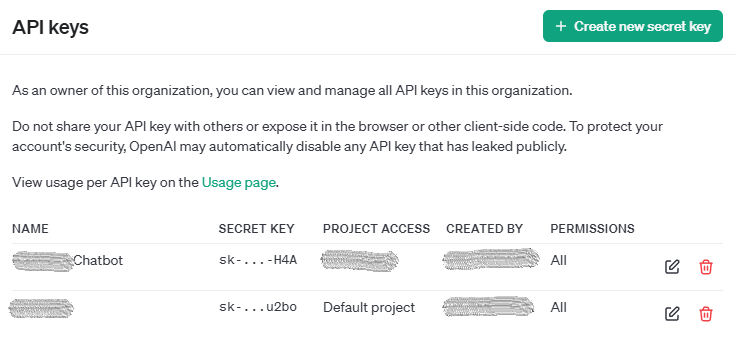How to create your Own AI Bot on WhatsApp Using the ABP Framework
This article demonstrates how to build a WhatsApp bot that uses ChatGPT’s conversational AI by integrating an ABP.io application template with Twilio and the OpenAI API. Through this setup, you will create a real-time interactive WhatsApp bot that leverages ChatGPT's advanced language processing capabilities to respond to user messages. This tutorial includes essential steps for configuring the ABP.io project template, setting up Twilio for WhatsApp messaging, and connecting to OpenAI’s API, enabling a powerful AI-driven communication tool on WhatsApp.
Set Up the ABP.io Project
Install ABP Studio: Download and install ABP Studio from ABP Studio.
Create New Solution: Select a solution template, specifically the "Application (Layered)" template.
Complete the Setup: Follow the prompts to complete the project setup.
Configure Twilio Account for WhatsApp Sandbox
Sign Up for Twilio: Register for a Twilio account if you don’t have one.
Activate WhatsApp Sandbox: In Twilio Console, navigate to Messaging > Try it Out > Send a WhatsApp message. Follow the provided instructions to join the WhatsApp Sandbox.
Generate API Credentials: Obtain your Twilio Account SID and Auth Token for API integration.

Set Up Webhook URL for Sandbox: Configure the “When a message comes in” webhook URL under Sandbox for WhatsApp in Twilio Console to point to your ABP application endpoint.

Set Up OpenAI API (ChatGPT)
Sign Up for OpenAI: Register an account at OpenAI and retrieve an API key for ChatGPT.

Develop API Endpoints in ABP Application
Add Twilio and OpenAI keys to appsettings.json
"Twilio": {
"AccountSid": "Your_Account_Sid_Here",
"AuthToken": "Your_Auth_Token_Here",
"WhatsAppNumber": "whatsapp:+14155278883",
"ContentTemplateSid": "Your_Content_Template_Sid_Here"
},
"OpenAI": {
"ApiUrl": "https://api.openai.com/v1/chat/completions",
"ApiKey": "Your_OpenAI_Api_Key_Here"
}
Install Twilio REST API helper library from Nuget
Key Classes and Their Functions:
OpenAiAppService
Purpose: Handles interactions with the OpenAI API, sending message threads to ChatGPT and receiving responses.
public class OpenAiAppService : ProjectAppService, IOpenAiAppService, ITransientDependency
{
// Private fields to store API URL, API Key, and HTTP client instance
private readonly string _apiUrl;
private readonly string _apiKey;
private readonly HttpClient _httpClient;
// Constructor to initialize OpenAiAppService with configuration and HTTP client
public OpenAiAppService(IConfiguration config, HttpClient httpClient)
{
// Get API URL from configuration; throw an exception if not found
_apiUrl = config["OpenAI:ApiUrl"] ?? throw new ArgumentNullException(nameof(config), "API URL cannot be null");
// Get API Key from configuration; throw an exception if not found
_apiKey = config["OpenAI:ApiKey"] ?? throw new ArgumentNullException(nameof(config), "API Key cannot be null");
// Initialize HTTP client and set the Authorization header with the API Key
_httpClient = httpClient;
_httpClient.DefaultRequestHeaders.Add("Authorization", $"Bearer {_apiKey}");
}
// Method to send a message thread to ChatGPT and get a response
public async Task<string> AskChatGpt(List<OpenAiThreadCacheDetails> messagesThread)
{
// Define the request content for the OpenAI API call
var requestContent = new
{
model = "gpt-4o", // Model to use (e.g., GPT-4)
messages = messagesThread.Select(s => new { role = s.Role, content = s.Message }).ToArray(), // Format message thread
temperature = 1, // Set temperature for response randomness
max_tokens = 2048, // Limit the response length
top_p = 1, // Controls diversity via nucleus sampling
frequency_penalty = 0, // Reduce repetitive word use
presence_penalty = 0, // Encourage topic diversity
response_format = new
{
type = "text" // Specify text response format
}
};
// Send POST request to OpenAI API
var response = await _httpClient.PostAsJsonAsync(_apiUrl, requestContent);
// Deserialize the response content
var result = await response.Content.ReadFromJsonAsync<JsonDocument>();
// Extract the response text; return a default message if no content is found
var reply = result?.RootElement.GetProperty("choices")[0].GetProperty("message").GetProperty("content").GetString() ?? "No idea!";
return reply;
}
}
OpenAiThreadCacheDetails
Purpose: Represents individual messages in a conversation thread, storing details for caching and reuse.
public class OpenAiThreadCacheDetails
{
// The role of the message sender (e.g., "user" or "assistant")
public required string Role { get; set; }
// The content of the message in the thread
public required string Message { get; set; }
}
WhatsAppService
Purpose: Manages communication between WhatsApp and ChatGPT by interacting with Twilio and OpenAI services.
public class WhatsAppService : ProjectAppService, IWhatsAppService, ITransientDependency
{
// Private fields for Twilio credentials, WhatsApp number, content SID, cache, and OpenAI service
private readonly string _accountSid;
private readonly string _authToken;
private readonly string _fromNumber;
private readonly string _contentSid;
private readonly IDistributedCache<List<OpenAiThreadCacheDetails>> _cache;
private readonly IOpenAiAppService _openAiAppService;
// Constructor to initialize WhatsAppService with configuration and dependencies
public WhatsAppService(IConfiguration config, IOpenAiAppService openAiAppService, IDistributedCache<List<OpenAiThreadCacheDetails>> cache)
{
// Retrieve Twilio credentials and WhatsApp number from configuration
_accountSid = config["Twilio:AccountSid"] ?? throw new ArgumentNullException(nameof(config), "Twilio:AccountSid is not configured.");
_authToken = config["Twilio:AuthToken"] ?? throw new ArgumentNullException(nameof(config), "Twilio:AuthToken is not configured.");
_fromNumber = config["Twilio:WhatsAppNumber"] ?? throw new ArgumentNullException(nameof(config), "Twilio:WhatsAppNumber is not configured.");
_contentSid = config["Twilio:ContentTemplateSid"] ?? throw new ArgumentNullException(nameof(config), "Twilio:ContentTemplateSid is not configured.");
// Initialize Twilio client with account SID and auth token
TwilioClient.Init(_accountSid, _authToken);
// Assign the OpenAI service and cache dependencies
_openAiAppService = openAiAppService;
_cache = cache;
}
// Method to send a text message via WhatsApp using Twilio
public async Task SendMessageAsync(string to, string message)
{
// Split the message into chunks if it exceeds a certain length
var splittedText = SplitText(message);
// Send each chunk of the message separately to avoid message length limits
foreach (var text in splittedText)
{
await MessageResource.CreateAsync(
from: new Twilio.Types.PhoneNumber(_fromNumber),
to: new Twilio.Types.PhoneNumber(to),
body: text
);
}
}
// Method to send a pre-defined template message via WhatsApp using Twilio
public async Task SendTemplateMessageAsync(string to)
{
await MessageResource.CreateAsync(
contentSid: _contentSid,
from: new Twilio.Types.PhoneNumber(_fromNumber),
to: new Twilio.Types.PhoneNumber(to)
);
}
// Method to receive a message, generate a response using ChatGPT, and send the response back
public async Task ReceiveMessageAsync(string from, string body)
{
// Get or initialize a cached conversation thread, adding the user's message
var cacheMessages = await GetOrSetCacheMessagesThread(from, "user", body);
// Ask ChatGPT for a response based on the message thread
var chatGptAnswer = await _openAiAppService.AskChatGpt(cacheMessages);
// Send ChatGPT's response back to the user on WhatsApp
await SendMessageAsync(from, chatGptAnswer);
}
// Helper method to get or initialize a cached message thread for a user
private async Task<List<OpenAiThreadCacheDetails>> GetOrSetCacheMessagesThread(string key, string role, string message)
{
// Attempt to retrieve the cached messages for the specified user
var cacheMessages = await _cache.GetAsync(key);
// If no cached messages are found, initialize with a new conversation including a system prompt
if (cacheMessages == null)
{
cacheMessages = new List<OpenAiThreadCacheDetails>
{
new OpenAiThreadCacheDetails
{
Role = "system",
Message = "You are a friendly and helpful assistant. Always provide clear, concise, and polite responses. Be attentive to the user’s questions, maintain a positive tone, and ensure your answers are accurate and supportive. Offer additional context when it might help the user, and encourage them to ask further questions if they need more clarification."
},
new OpenAiThreadCacheDetails
{
Role = role,
Message = message
}
};
// Cache the new conversation thread with an expiration time of 1 hour
await _cache.SetAsync(key, cacheMessages, new DistributedCacheEntryOptions
{
AbsoluteExpirationRelativeToNow = TimeSpan.FromHours(1)
});
}
else
{
// If cached messages exist, add the new message to the conversation thread
cacheMessages.Add(new OpenAiThreadCacheDetails
{
Role = role,
Message = message
});
// Update the cache with the modified conversation thread
await _cache.SetAsync(key, cacheMessages, new DistributedCacheEntryOptions
{
AbsoluteExpirationRelativeToNow = TimeSpan.FromHours(1)
});
}
return cacheMessages;
}
// Helper method to split text into smaller chunks based on a maximum size limit
private static List<string> SplitText(string text, int maxChunkSize = 1600)
{
var result = new List<string>();
// Return an empty list if the text is null or empty
if (string.IsNullOrWhiteSpace(text))
{
return result;
}
int startIndex = 0;
while (startIndex < text.Length)
{
// Calculate the maximum end index for the current chunk
int endIndex = Math.Min(startIndex + maxChunkSize, text.Length);
// Adjust end index to a space character if needed for proper word boundaries
if (endIndex < text.Length && text[endIndex] != ' ')
{
int lastSpaceIndex = text.LastIndexOf(' ', endIndex);
if (lastSpaceIndex > startIndex)
{
endIndex = lastSpaceIndex;
}
}
// Extract the chunk and add it to the result list
string chunk = text.Substring(startIndex, endIndex - startIndex).Trim();
result.Add(chunk);
// Move the start index to the next position after the current chunk
startIndex = endIndex + 1;
}
return result;
}
}
WhatsAppController
Purpose: Provides an HTTP API endpoint to receive incoming WhatsApp messages, trigger responses from ChatGPT, and return replies to the user.
[ControllerName("WhatsApp")]
public class WhatsAppController : TwilioController
{
// Declare a private readonly field for the WhatsApp service interface
private readonly IWhatsAppService _whatsAppService;
// Constructor that initializes the WhatsApp service dependency
public WhatsAppController(IWhatsAppService whatsAppService)
{
_whatsAppService = whatsAppService;
}
// Define a POST endpoint to receive incoming WhatsApp messages
// The endpoint is accessible without authentication, for testing purposes only!
[HttpPost]
[Route("receive")]
[AllowAnonymous]
public async Task<IActionResult> ReceiveMessageAsync([FromForm] string From, [FromForm] string Body)
{
// Call the WhatsApp service to handle the received message
await _whatsAppService.ReceiveMessageAsync(From, Body);
// Return an OK response to acknowledge message receipt
return Ok();
}
}
Final Steps: Testing and Deployment
Once a WhatsApp user sends a message to your Twilio-provided number, the API you’ve built receives it, forwards it to ChatGPT, and sends the response back via WhatsApp. This bot setup offers an interactive, AI-driven experience that showcases the power of integrating ABP.io, Twilio, and OpenAI for customer engagement on WhatsApp.
To test the bot locally, you can use a tool like ngrok to expose your local server to the internet. Run ngrok and link it to your local server's port, then update the webhook URL in Twilio to use the ngrok address.
Additionally, restrict the receive endpoint with authorization in production to secure access and ensure only authorized requests reach your bot.


























































Comments
Alper Ebiçoğlu 56 weeks ago
great article
Sergei Gorlovetsky 48 weeks ago
Awesome guide!